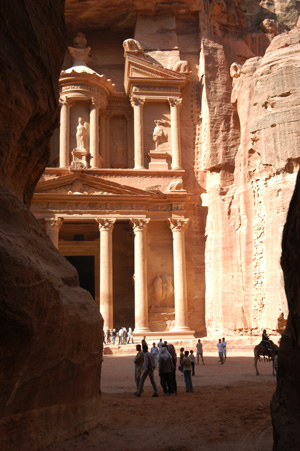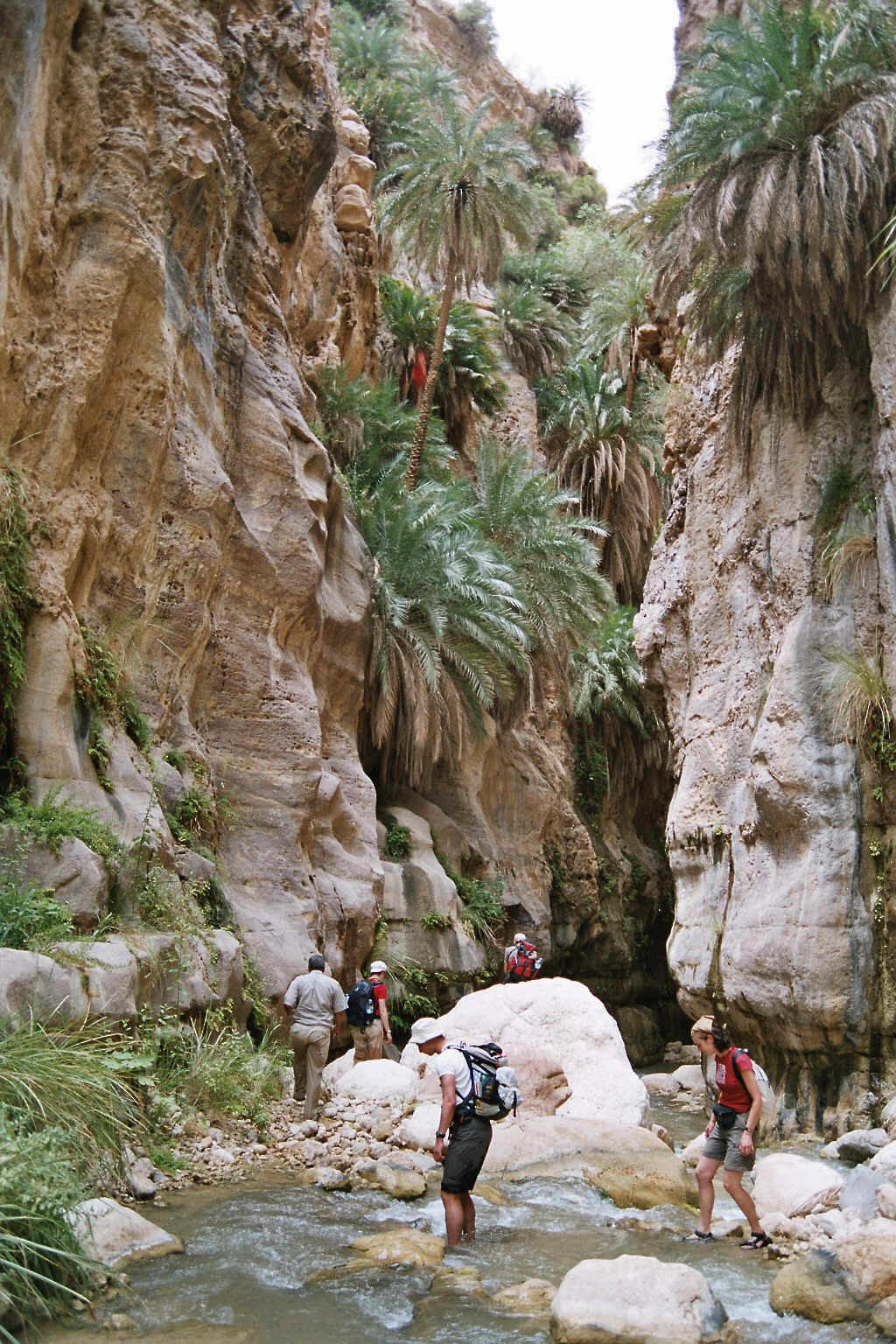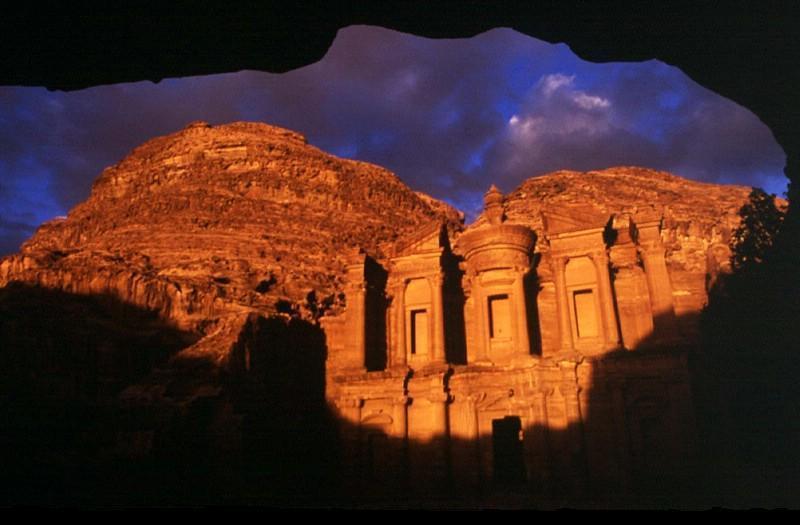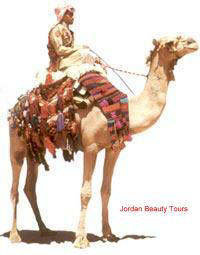|
THE GRANDEUR OF PETRA, THE SPLENDORS OF
JORDAN

The Royal Hashemite Kingdom of Jordan is a charming land that has
preserved a remarkable character unlike any other in the Near East.
Ruled by the recently enthroned King Abdullah (H.E.), (His brother,
Prince Feisal, graduated from Brown in 1985) the people have an
unparalleled reputation for hospitality, from the office worker in the
city to the Bedouin in his desert camp. Parts of the country are so rich
in archaeology that it is literally impossible not to step tens of
thousands of years back into time. The unique majesty of Petra, the
Roman splendor of Jerash, and the elegant Omayyad fortress-palaces
scattered in the eastern desert are only a few of the major attractions.
And in addition to a splendid wealth of ancient cities, castles,
Christian churches, and mosaic masterpieces, the landscape offers some
of the most breathtaking vistas to be had anywhere on earth.

This 13 day trip has been designed to provide you with the resources and
the time to gain an understanding and appreciation of the country and
its compelling history. The itinerary includes several highlights,
including private tours of the archaeological site at Petra, the
marvelous repository of Nabataean culture, and ACOR, the American Center
of Oriental Research. Here we will enjoy a private tour of collections,
including the intriguing Petra Scrolls, guided by Center Director Pierre
Bikai.
Travel to Jordan/Petra
ITINERARY:
(B) breakfast, (L) lunch, (D) dinner
DAY 1: Arrive Amman. Transfer to the Days Inn Hotel, our
base for the next five nights. (D)
DAY 2: Begin today at one of the best-preserved examples
of medieval Arab military architecture in the entire Middle East, the
12th-century Ajlun Castle. Continue to the most dramatically located
ancient city in Jordan, Umm Quais, perched on a high plain overlooking
the Jordan Valley and the Sea of Galilee. At Pella we will see mud-brick
houses and fortification walls dating from the Bronze and Iron age
towns, and the later remains from the Roman, Byzantine, and early
Islamic periods. Gather this evening for our elegant welcome dinner
party, held in a local restaurant. (B/L/D)
DAY 3: We begin today's exploration of Amman by climbing
up to the Citadel, dominating the vibrant city of Amman. Here, we will
visit the National Archaeological Museum for an overview of Jordan's
past. The Dead Sea Scrolls found in 1952 are one of the most important
exhibits here. Continue to the nearby 8th century Omayyad Palace, the
Temple of Hercules dedicated to the Roman Emperor Marcus Aurelius in the
2nd-century, and a small Byzantine church. Learn of the Roman city while
viewing the amphitheater that seats 6,000 people and is still used for
performances today, and the recently-restored odean. In the afternoon,
drive to 'Ain Ghazal, the site worked by our study leader. We will then
visit the American Center of Oriental Research (ACOR), where the
director will give us a private tour including seeing the Petra Scrolls.
 Dinner
is own our own to enjoy one of Amman's superb restaurants. (B/L) Dinner
is own our own to enjoy one of Amman's superb restaurants. (B/L)
DAY 4: Today’s all day tour takes us east of Amman along ancient desert
tracks to explore several spectacular Omayyad palaces. The exquisite
brickwork and colossal size of Qasr Mushatta make this one of the most
extraordinary of all the castles. Twenty-three round towers nestle
within the brick walls that encircled the huge complex. Oasr al-Hallabat
began as a Roman fort and ended as a luxurious country estate under the
Omayyads. Nearby is its bathhouse, Hammam al-Sarah, constructed of fine
limestone. Crafted of the area’s black basalt, Azraq Castle is located
in an oasis and takes advantage of the important strategic position of
the region’s four springs. The fortress was probably begun in the second
century AD by the Romans, and was still in use when T. E. Lawrence used
it as a base in the winter of 1917-18. The audience hall at Qusayr Amra
is covered by three barrel-vaults; the ceilings and walls are covered
with charming, vividly painted frescoes. And the mighty fortress of Qasr
al-Kharaneh is the most complete of the Omayyad castles. Even though the
steep walls rising abruptly from the flat plain create a feeling of
strength, archaeological excavations show that the building was probably
used as an elegant palace. (B/L/D)
DAY 5: An all day tour takes us to two impressive sites. West of Amman
is Wadi as-Seer, one of the most attractive valleys in Jordan and
containing Qasr al-Abd, the Palace of the Slave. This important
Hellenistic palace is one of the most interesting ancient monuments in
the Middle East. Nestled in a green and fertile valley in the biblical
land of Gilead, the remains of Jerash are impressive. Stroll along the
city’s colonnaded streets and through ancient marketplaces, and visit
imposing theaters sitting beside Roman, Christian and Muslim houses of
worship. (B/L/D)
DAY 6: Today is filled with history. Madaba was inhabited
for nearly 3,500 years, and contains the most impressive work of art to
survive from the mid-6th century - a mosaic map of Palestine, located
within St. George’s Church. Bible references speak of Mt. Nebo as the
place where Moses died. Visit the ruins of the 6th-century basilica, the
Chapel of the Virgin Mary, and the monastery. The Church of Saints Lot
and Procopius, Martyrs contains a masterpiece of the Madaba School of
mosaics. Nearby Maqdas is a recently discovered baptismal site on the
Jordan River. This evening’s welcome to Petra includes cocktails with
Brown University’s Martha Sharp Joukowsky and the staff of the Great
Temple Project. Overnight four nights in Petra at the Petra Movenpick
Hotel. (B/L/D)
DAY 7: Early this morning, we will walk through the siq,
the fissure that is the gateway to the splendid capital city that the
Nabataean Arabs carved and built at Petra almost 2,500 years ago. Here,
we will meet with the man who has spent the last decade studying this
entrance to the great city. Ueli will give us a privately arranged tour
to show us the secrets that have been exposed by his work. Our first
view of the Rose City is the dazzling Al-Khasneh Farun, or Treasury.
From here walk along the Streets of Facades and view the magnificent
tombs, theatre, markets, the Petra Church with its glorious mosaics, and
the Great Temple, being excavated by Brown University. In the evening,
we will enjoy a zarb, a traditional Bedouin meal of roasted lamb cooked
in a hand-built mud oven. (B/L/D)
DAY 8: Early this morning we will continue our exploration
of Petra by climbing into the more remote areas. This climb is for the
hard y!
Begin in Qasr al-Bint Temple, the most impressive structure dating from
the time of Christ. The small mountain overlooking the temple is al-Habees.
Walk to the Habees High Place, one of the easiest of the climbs
overlooking the city. Pass the Unfinished Tomb showing that the
Nabataeans carved from the top down, and the Columbarium, a former tomb
with hundreds of small niches. Continue to the 12th-century Crusader
fortress on the summit of al-Habees. For those who want to continue
climbing, visit the Lion Triclinium guarded by two feline reliefs,
Qattar ad-Deir to see theNabataeans’ water source. After lunch onsite,
we will join Dr. Joukowsky as she takes us through the Brown University
excavations in the Great Temple, including a private viewing of the
artifacts found during excavations and now being analyzed in the
project’s lab. In the afternoon, visit the small museum onsite. Dinner
is on our own. (B/L) y!
Begin in Qasr al-Bint Temple, the most impressive structure dating from
the time of Christ. The small mountain overlooking the temple is al-Habees.
Walk to the Habees High Place, one of the easiest of the climbs
overlooking the city. Pass the Unfinished Tomb showing that the
Nabataeans carved from the top down, and the Columbarium, a former tomb
with hundreds of small niches. Continue to the 12th-century Crusader
fortress on the summit of al-Habees. For those who want to continue
climbing, visit the Lion Triclinium guarded by two feline reliefs,
Qattar ad-Deir to see theNabataeans’ water source. After lunch onsite,
we will join Dr. Joukowsky as she takes us through the Brown University
excavations in the Great Temple, including a private viewing of the
artifacts found during excavations and now being analyzed in the
project’s lab. In the afternoon, visit the small museum onsite. Dinner
is on our own. (B/L)
DAY 9: One of the marvels of the Classical World, Petra
offers much more than stunning antiquities. Within a 25-mile radius, we
will explore an exceptional array of monuments and entire settlements
that span the last 9,000 years of human civilization. This morning’s
drive takes us to Beidha, one of the most magical ancient sites in the
entire Middle East. Walk among the standing walls, plastered floors and
doorways of a village that was inhabited between 7000-6500 BC, at a time
when humankind was first making the transition from nomadic
hunter-gatherers to year-round settled villages. Nearby is “Little
Petra”, or Siq al-Barid, where we will see several immense cisterns
carved into the rocks, and after walking through a miniature siq, or
fissure in the rock cliff, a splendid collection of tombs, temples,
houses, and staircases will appear before us. (B/L/D)

DAY 10: Our full day drive will take us past the Seven Pillars of
Wisdom, of T. E. Lawrence fame, to Wadi Rum. Known to the Arabs as The
Valley of the Moon, Wadi Rum’s combination of immensity, richness of
color, and awesome shapes creates an atmosphere that is other worldly.
After exploring the valley, the largest and grandest of a network of
valleys used by trading caravans to the Arabian peninsula, return to
Wadi Musa. Dinner is on our own. (B/L)
DAY 11: This morning’s climb takes us to Ed Deir to view a temple with
the largest façade carved at Petra. After lunch we will return to Amman.
End the day with a stop at Bani Hamida House, home to a Bedouin women's
craft project, to see beautiful flat weave rugs for sale. Gather this
evening for our final dinner party in one of Amman's finest restaurants.
(B/L/D)
DAY 12: Begin the day at Umm el Jimal, located at the edge of the
eastern desert and inhabited for more than seven centuries. Encircled by
formidable walls, the huge metropolis contains buildings constructed of
black basalt blocks. We will then join Jordanian archaeologist, Lutfi
Khalil, who will take us through the fascinating site of Yajuuz and show
us what his work here has exposed. After returning to Amman we will
visit the Jordanian Museum of Popular Traditions to view an exquisite
collection of clothing and jewelry from the area. Dinner is on our own.
(B/L)
DAY 13: An early morning transfer to the airport for our
departure. (B)
AIR FARE: Jordan Beauty can confirm flights on Royal
Jordanian Airlines for exceptional rates. Add-on fares from gateway
cities are also available at a reduced cost. Please note that if
participants arrive and depart Amman on flights other than the group
flights, additional transfer costs will be charged
PRIVATE TOURS OF ARCHAEOLOGICAL SITES:
The private tours of archaeological sites and talks by specialists are
scheduled in advance and include a donation to each. Specialists working
at these sites are excited about showing their work to interested
enthusiasts. However, please be aware that there may be times when the
director or a member of the staff may not be onsite when our groups
arrive due to other commitments, or that the date or time of our visit
to their project must be changed.
TRIP LIMITED TO 25 PARTICIPANTS
|